Electric Vehicle Industry Report: Opportunities and Challenges
VerifiedAdded on 2023/01/12
|9
|2547
|62
Report
AI Summary
This report examines the electric vehicle (EV) industry, focusing on the identification of new business opportunities associated with the production and marketing of electric cars. The analysis begins with an introduction to the automotive industry, highlighting the impact of technology and the trend towards electric vehicles, using Volo Cars as a case study. The main body of the report identifies emerging business opportunities through PESTLE and Porter's Five Forces models, considering political, economic, social, technological, legal, and environmental factors. It also critically assesses the long-term profitability of businesses investing in EVs, contrasting Volvo's approach with other market players, and utilizing the Porter value chain model to analyze coordination and efficiency. The report concludes that electrification in the automotive industry offers numerous benefits, including environmental protection and reduced reliance on fossil fuels, while acknowledging potential short-term challenges in coordination and implementation.
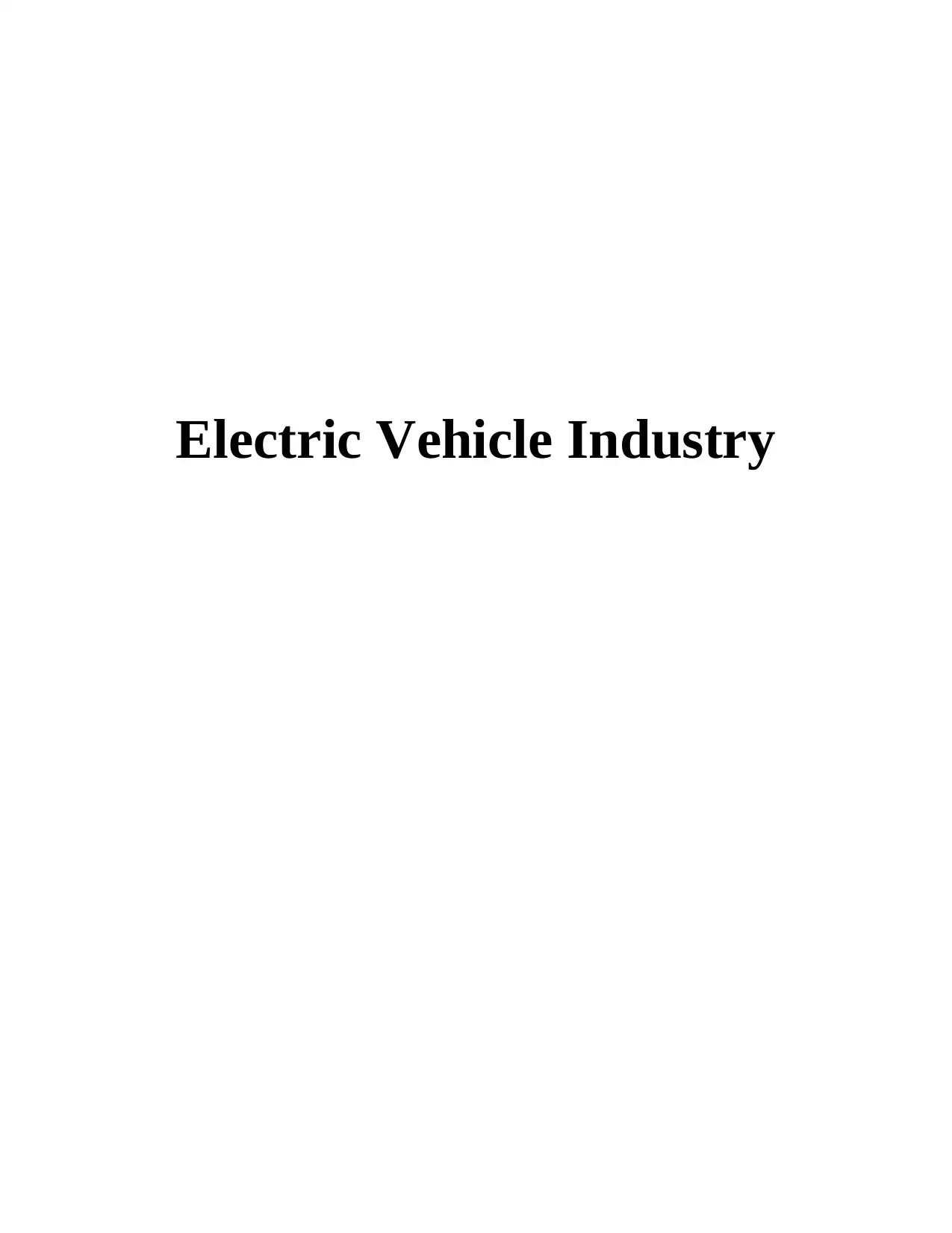
Electric Vehicle Industry
Paraphrase This Document
Need a fresh take? Get an instant paraphrase of this document with our AI Paraphraser
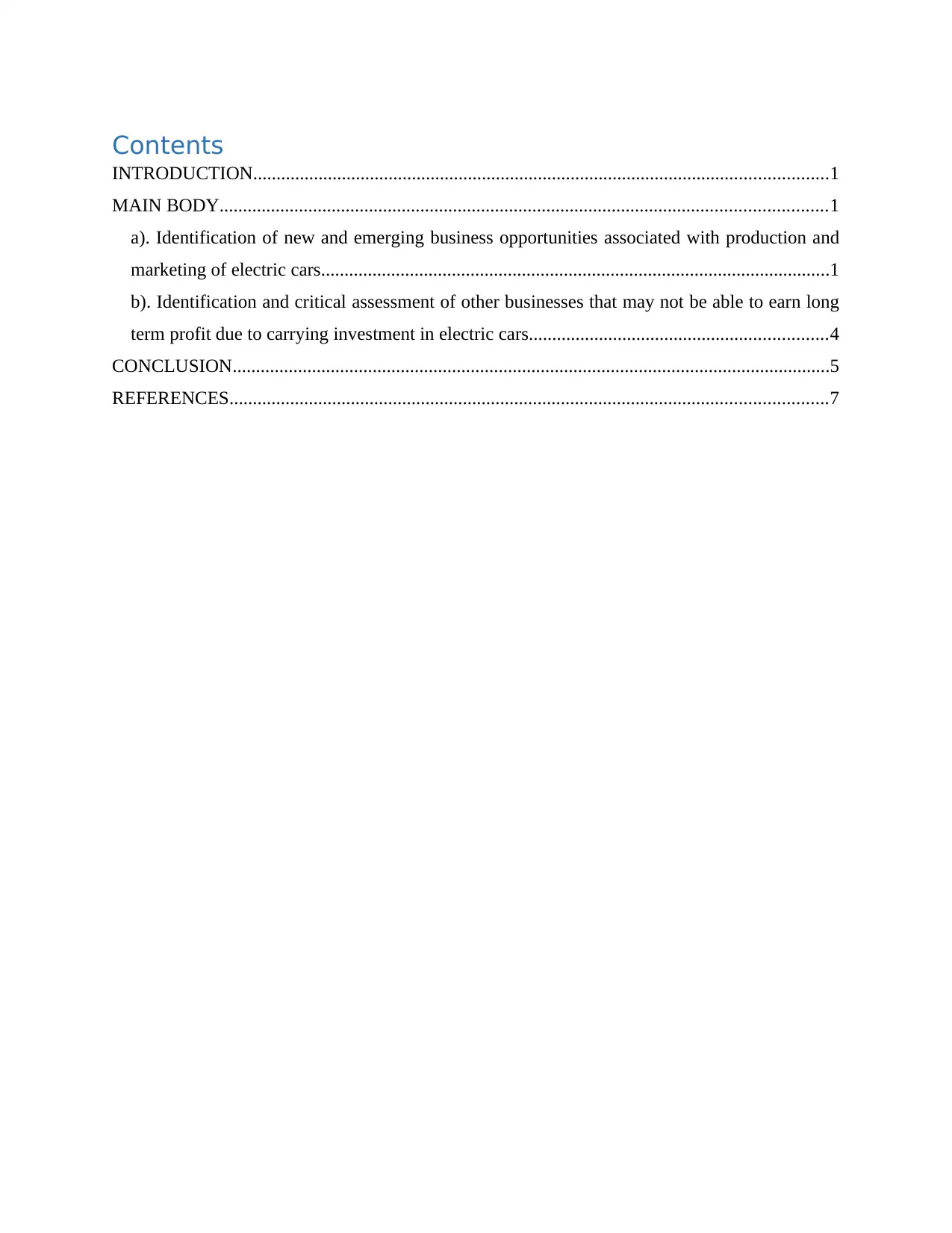
Contents
INTRODUCTION...........................................................................................................................1
MAIN BODY..................................................................................................................................1
a). Identification of new and emerging business opportunities associated with production and
marketing of electric cars.............................................................................................................1
b). Identification and critical assessment of other businesses that may not be able to earn long
term profit due to carrying investment in electric cars................................................................4
CONCLUSION................................................................................................................................5
REFERENCES................................................................................................................................7
INTRODUCTION...........................................................................................................................1
MAIN BODY..................................................................................................................................1
a). Identification of new and emerging business opportunities associated with production and
marketing of electric cars.............................................................................................................1
b). Identification and critical assessment of other businesses that may not be able to earn long
term profit due to carrying investment in electric cars................................................................4
CONCLUSION................................................................................................................................5
REFERENCES................................................................................................................................7
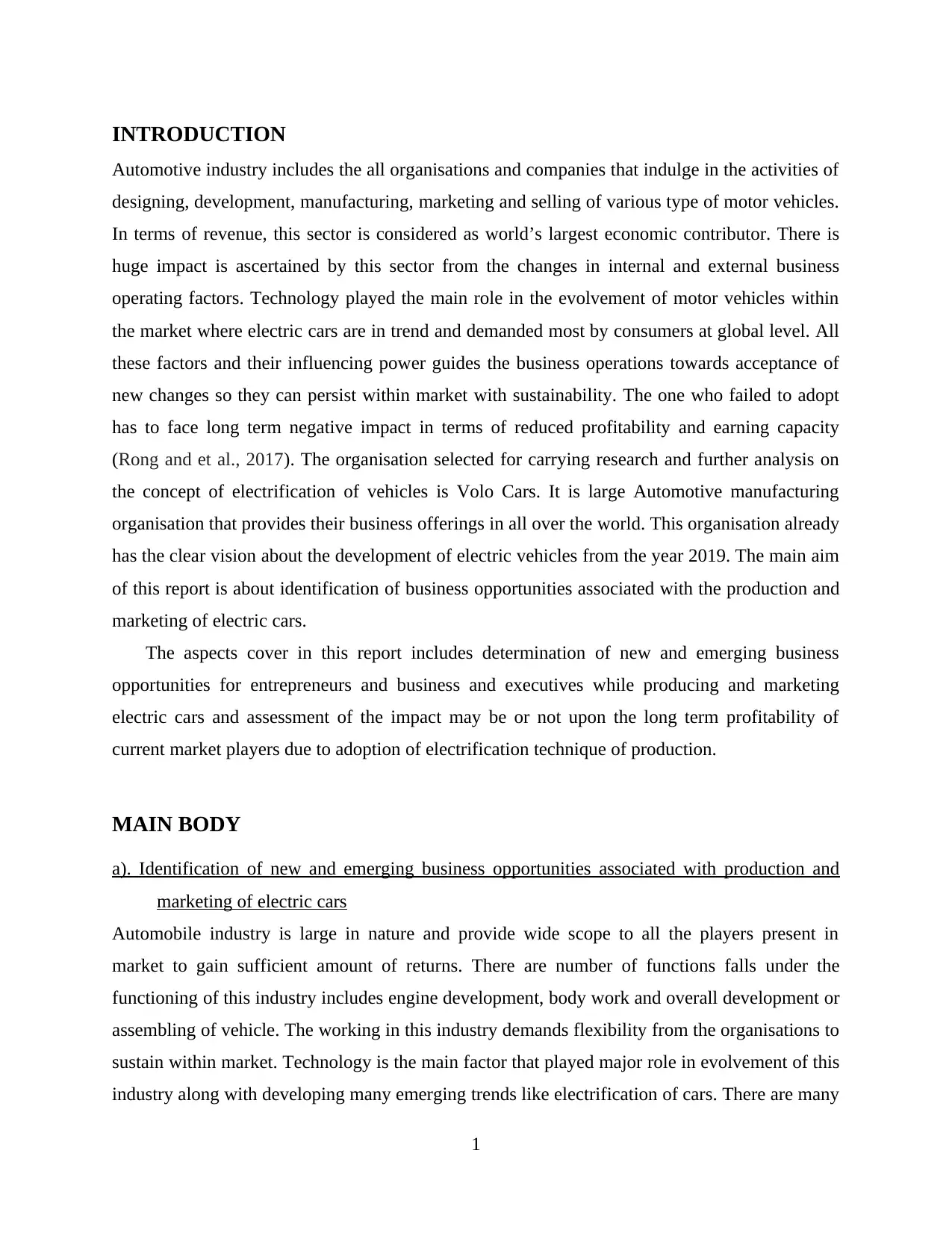
INTRODUCTION
Automotive industry includes the all organisations and companies that indulge in the activities of
designing, development, manufacturing, marketing and selling of various type of motor vehicles.
In terms of revenue, this sector is considered as world’s largest economic contributor. There is
huge impact is ascertained by this sector from the changes in internal and external business
operating factors. Technology played the main role in the evolvement of motor vehicles within
the market where electric cars are in trend and demanded most by consumers at global level. All
these factors and their influencing power guides the business operations towards acceptance of
new changes so they can persist within market with sustainability. The one who failed to adopt
has to face long term negative impact in terms of reduced profitability and earning capacity
(Rong and et al., 2017). The organisation selected for carrying research and further analysis on
the concept of electrification of vehicles is Volo Cars. It is large Automotive manufacturing
organisation that provides their business offerings in all over the world. This organisation already
has the clear vision about the development of electric vehicles from the year 2019. The main aim
of this report is about identification of business opportunities associated with the production and
marketing of electric cars.
The aspects cover in this report includes determination of new and emerging business
opportunities for entrepreneurs and business and executives while producing and marketing
electric cars and assessment of the impact may be or not upon the long term profitability of
current market players due to adoption of electrification technique of production.
MAIN BODY
a). Identification of new and emerging business opportunities associated with production and
marketing of electric cars
Automobile industry is large in nature and provide wide scope to all the players present in
market to gain sufficient amount of returns. There are number of functions falls under the
functioning of this industry includes engine development, body work and overall development or
assembling of vehicle. The working in this industry demands flexibility from the organisations to
sustain within market. Technology is the main factor that played major role in evolvement of this
industry along with developing many emerging trends like electrification of cars. There are many
1
Automotive industry includes the all organisations and companies that indulge in the activities of
designing, development, manufacturing, marketing and selling of various type of motor vehicles.
In terms of revenue, this sector is considered as world’s largest economic contributor. There is
huge impact is ascertained by this sector from the changes in internal and external business
operating factors. Technology played the main role in the evolvement of motor vehicles within
the market where electric cars are in trend and demanded most by consumers at global level. All
these factors and their influencing power guides the business operations towards acceptance of
new changes so they can persist within market with sustainability. The one who failed to adopt
has to face long term negative impact in terms of reduced profitability and earning capacity
(Rong and et al., 2017). The organisation selected for carrying research and further analysis on
the concept of electrification of vehicles is Volo Cars. It is large Automotive manufacturing
organisation that provides their business offerings in all over the world. This organisation already
has the clear vision about the development of electric vehicles from the year 2019. The main aim
of this report is about identification of business opportunities associated with the production and
marketing of electric cars.
The aspects cover in this report includes determination of new and emerging business
opportunities for entrepreneurs and business and executives while producing and marketing
electric cars and assessment of the impact may be or not upon the long term profitability of
current market players due to adoption of electrification technique of production.
MAIN BODY
a). Identification of new and emerging business opportunities associated with production and
marketing of electric cars
Automobile industry is large in nature and provide wide scope to all the players present in
market to gain sufficient amount of returns. There are number of functions falls under the
functioning of this industry includes engine development, body work and overall development or
assembling of vehicle. The working in this industry demands flexibility from the organisations to
sustain within market. Technology is the main factor that played major role in evolvement of this
industry along with developing many emerging trends like electrification of cars. There are many
1
⊘ This is a preview!⊘
Do you want full access?
Subscribe today to unlock all pages.

Trusted by 1+ million students worldwide
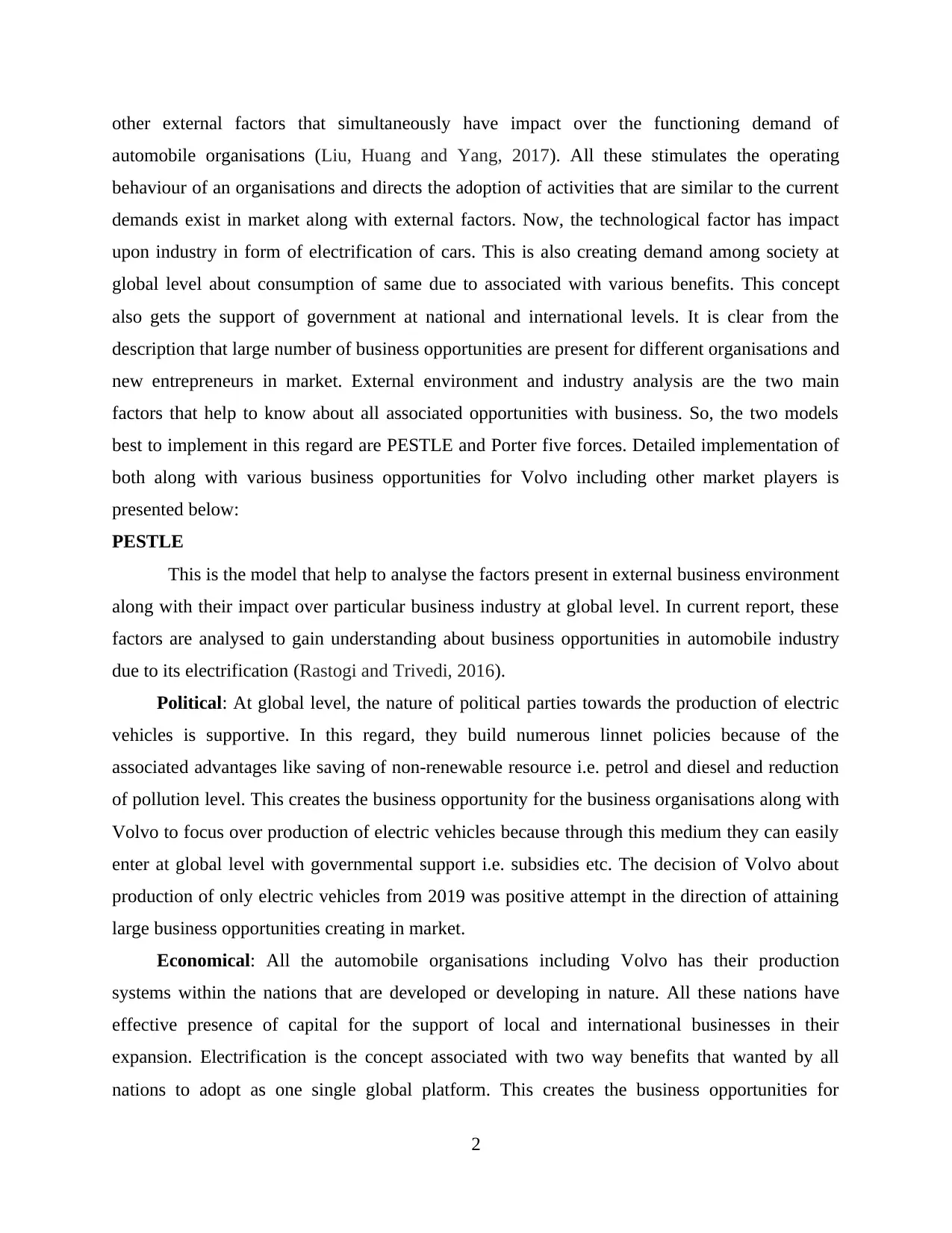
other external factors that simultaneously have impact over the functioning demand of
automobile organisations (Liu, Huang and Yang, 2017). All these stimulates the operating
behaviour of an organisations and directs the adoption of activities that are similar to the current
demands exist in market along with external factors. Now, the technological factor has impact
upon industry in form of electrification of cars. This is also creating demand among society at
global level about consumption of same due to associated with various benefits. This concept
also gets the support of government at national and international levels. It is clear from the
description that large number of business opportunities are present for different organisations and
new entrepreneurs in market. External environment and industry analysis are the two main
factors that help to know about all associated opportunities with business. So, the two models
best to implement in this regard are PESTLE and Porter five forces. Detailed implementation of
both along with various business opportunities for Volvo including other market players is
presented below:
PESTLE
This is the model that help to analyse the factors present in external business environment
along with their impact over particular business industry at global level. In current report, these
factors are analysed to gain understanding about business opportunities in automobile industry
due to its electrification (Rastogi and Trivedi, 2016).
Political: At global level, the nature of political parties towards the production of electric
vehicles is supportive. In this regard, they build numerous linnet policies because of the
associated advantages like saving of non-renewable resource i.e. petrol and diesel and reduction
of pollution level. This creates the business opportunity for the business organisations along with
Volvo to focus over production of electric vehicles because through this medium they can easily
enter at global level with governmental support i.e. subsidies etc. The decision of Volvo about
production of only electric vehicles from 2019 was positive attempt in the direction of attaining
large business opportunities creating in market.
Economical: All the automobile organisations including Volvo has their production
systems within the nations that are developed or developing in nature. All these nations have
effective presence of capital for the support of local and international businesses in their
expansion. Electrification is the concept associated with two way benefits that wanted by all
nations to adopt as one single global platform. This creates the business opportunities for
2
automobile organisations (Liu, Huang and Yang, 2017). All these stimulates the operating
behaviour of an organisations and directs the adoption of activities that are similar to the current
demands exist in market along with external factors. Now, the technological factor has impact
upon industry in form of electrification of cars. This is also creating demand among society at
global level about consumption of same due to associated with various benefits. This concept
also gets the support of government at national and international levels. It is clear from the
description that large number of business opportunities are present for different organisations and
new entrepreneurs in market. External environment and industry analysis are the two main
factors that help to know about all associated opportunities with business. So, the two models
best to implement in this regard are PESTLE and Porter five forces. Detailed implementation of
both along with various business opportunities for Volvo including other market players is
presented below:
PESTLE
This is the model that help to analyse the factors present in external business environment
along with their impact over particular business industry at global level. In current report, these
factors are analysed to gain understanding about business opportunities in automobile industry
due to its electrification (Rastogi and Trivedi, 2016).
Political: At global level, the nature of political parties towards the production of electric
vehicles is supportive. In this regard, they build numerous linnet policies because of the
associated advantages like saving of non-renewable resource i.e. petrol and diesel and reduction
of pollution level. This creates the business opportunity for the business organisations along with
Volvo to focus over production of electric vehicles because through this medium they can easily
enter at global level with governmental support i.e. subsidies etc. The decision of Volvo about
production of only electric vehicles from 2019 was positive attempt in the direction of attaining
large business opportunities creating in market.
Economical: All the automobile organisations including Volvo has their production
systems within the nations that are developed or developing in nature. All these nations have
effective presence of capital for the support of local and international businesses in their
expansion. Electrification is the concept associated with two way benefits that wanted by all
nations to adopt as one single global platform. This creates the business opportunities for
2
Paraphrase This Document
Need a fresh take? Get an instant paraphrase of this document with our AI Paraphraser
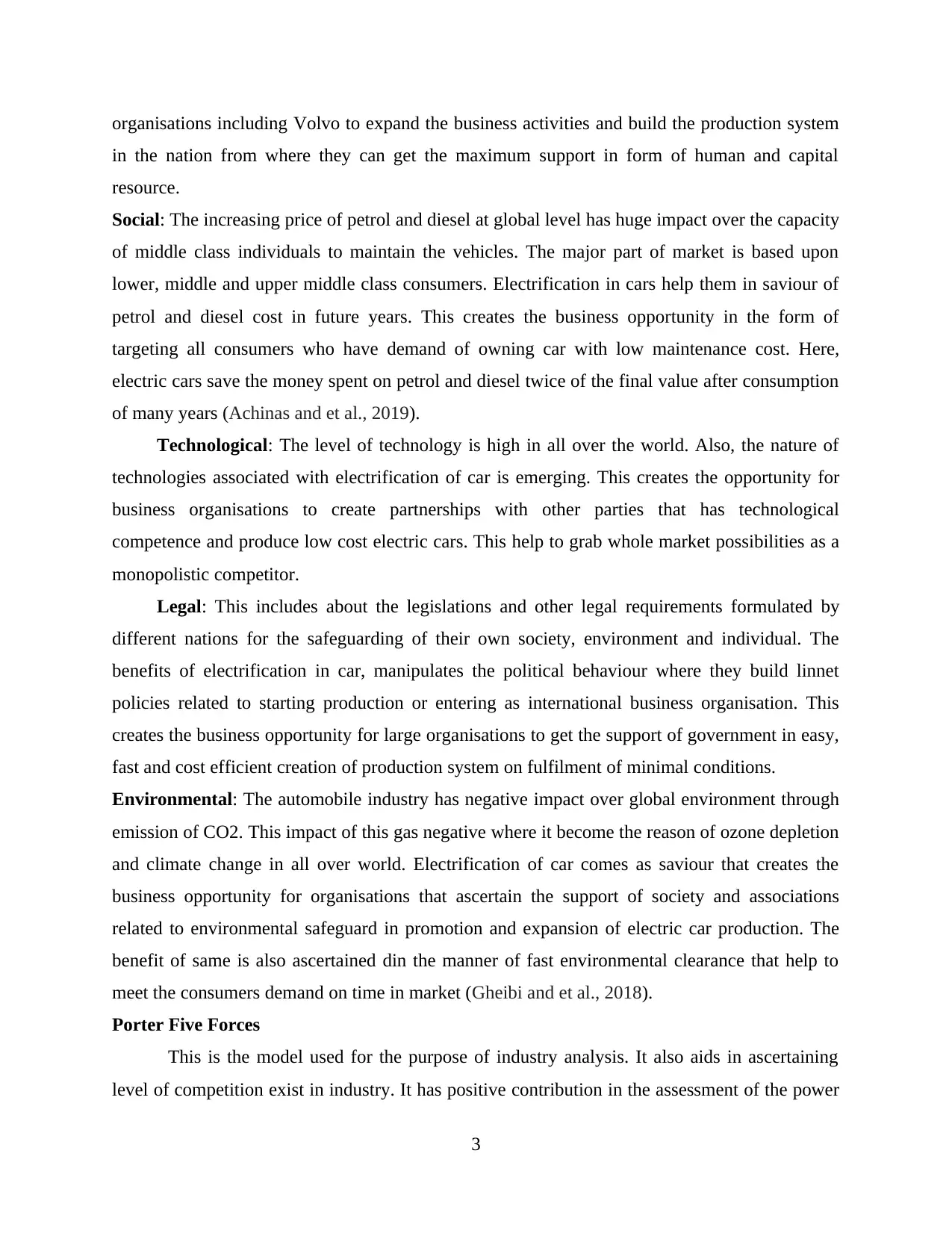
organisations including Volvo to expand the business activities and build the production system
in the nation from where they can get the maximum support in form of human and capital
resource.
Social: The increasing price of petrol and diesel at global level has huge impact over the capacity
of middle class individuals to maintain the vehicles. The major part of market is based upon
lower, middle and upper middle class consumers. Electrification in cars help them in saviour of
petrol and diesel cost in future years. This creates the business opportunity in the form of
targeting all consumers who have demand of owning car with low maintenance cost. Here,
electric cars save the money spent on petrol and diesel twice of the final value after consumption
of many years (Achinas and et al., 2019).
Technological: The level of technology is high in all over the world. Also, the nature of
technologies associated with electrification of car is emerging. This creates the opportunity for
business organisations to create partnerships with other parties that has technological
competence and produce low cost electric cars. This help to grab whole market possibilities as a
monopolistic competitor.
Legal: This includes about the legislations and other legal requirements formulated by
different nations for the safeguarding of their own society, environment and individual. The
benefits of electrification in car, manipulates the political behaviour where they build linnet
policies related to starting production or entering as international business organisation. This
creates the business opportunity for large organisations to get the support of government in easy,
fast and cost efficient creation of production system on fulfilment of minimal conditions.
Environmental: The automobile industry has negative impact over global environment through
emission of CO2. This impact of this gas negative where it become the reason of ozone depletion
and climate change in all over world. Electrification of car comes as saviour that creates the
business opportunity for organisations that ascertain the support of society and associations
related to environmental safeguard in promotion and expansion of electric car production. The
benefit of same is also ascertained din the manner of fast environmental clearance that help to
meet the consumers demand on time in market (Gheibi and et al., 2018).
Porter Five Forces
This is the model used for the purpose of industry analysis. It also aids in ascertaining
level of competition exist in industry. It has positive contribution in the assessment of the power
3
in the nation from where they can get the maximum support in form of human and capital
resource.
Social: The increasing price of petrol and diesel at global level has huge impact over the capacity
of middle class individuals to maintain the vehicles. The major part of market is based upon
lower, middle and upper middle class consumers. Electrification in cars help them in saviour of
petrol and diesel cost in future years. This creates the business opportunity in the form of
targeting all consumers who have demand of owning car with low maintenance cost. Here,
electric cars save the money spent on petrol and diesel twice of the final value after consumption
of many years (Achinas and et al., 2019).
Technological: The level of technology is high in all over the world. Also, the nature of
technologies associated with electrification of car is emerging. This creates the opportunity for
business organisations to create partnerships with other parties that has technological
competence and produce low cost electric cars. This help to grab whole market possibilities as a
monopolistic competitor.
Legal: This includes about the legislations and other legal requirements formulated by
different nations for the safeguarding of their own society, environment and individual. The
benefits of electrification in car, manipulates the political behaviour where they build linnet
policies related to starting production or entering as international business organisation. This
creates the business opportunity for large organisations to get the support of government in easy,
fast and cost efficient creation of production system on fulfilment of minimal conditions.
Environmental: The automobile industry has negative impact over global environment through
emission of CO2. This impact of this gas negative where it become the reason of ozone depletion
and climate change in all over world. Electrification of car comes as saviour that creates the
business opportunity for organisations that ascertain the support of society and associations
related to environmental safeguard in promotion and expansion of electric car production. The
benefit of same is also ascertained din the manner of fast environmental clearance that help to
meet the consumers demand on time in market (Gheibi and et al., 2018).
Porter Five Forces
This is the model used for the purpose of industry analysis. It also aids in ascertaining
level of competition exist in industry. It has positive contribution in the assessment of the power
3
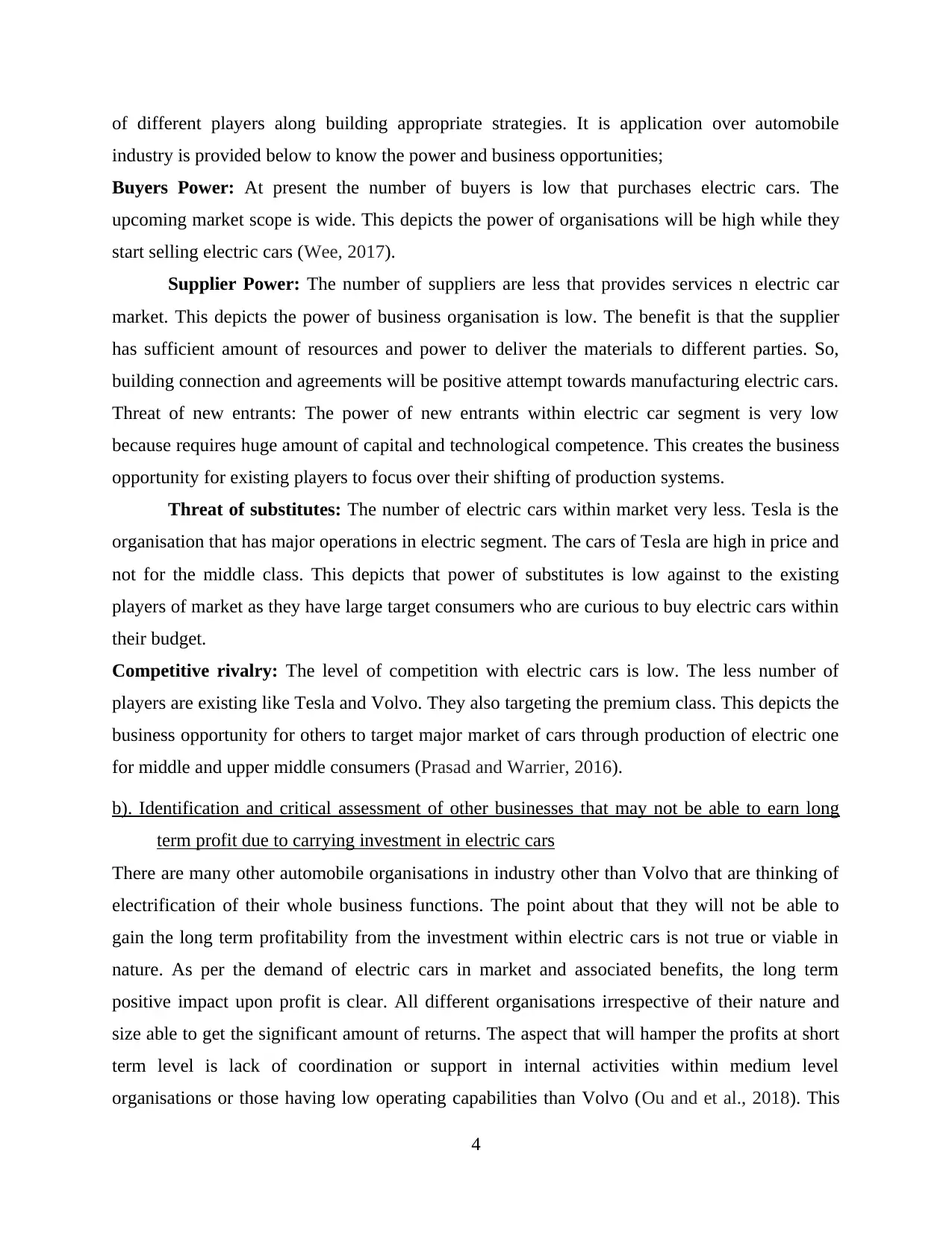
of different players along building appropriate strategies. It is application over automobile
industry is provided below to know the power and business opportunities;
Buyers Power: At present the number of buyers is low that purchases electric cars. The
upcoming market scope is wide. This depicts the power of organisations will be high while they
start selling electric cars (Wee, 2017).
Supplier Power: The number of suppliers are less that provides services n electric car
market. This depicts the power of business organisation is low. The benefit is that the supplier
has sufficient amount of resources and power to deliver the materials to different parties. So,
building connection and agreements will be positive attempt towards manufacturing electric cars.
Threat of new entrants: The power of new entrants within electric car segment is very low
because requires huge amount of capital and technological competence. This creates the business
opportunity for existing players to focus over their shifting of production systems.
Threat of substitutes: The number of electric cars within market very less. Tesla is the
organisation that has major operations in electric segment. The cars of Tesla are high in price and
not for the middle class. This depicts that power of substitutes is low against to the existing
players of market as they have large target consumers who are curious to buy electric cars within
their budget.
Competitive rivalry: The level of competition with electric cars is low. The less number of
players are existing like Tesla and Volvo. They also targeting the premium class. This depicts the
business opportunity for others to target major market of cars through production of electric one
for middle and upper middle consumers (Prasad and Warrier, 2016).
b). Identification and critical assessment of other businesses that may not be able to earn long
term profit due to carrying investment in electric cars
There are many other automobile organisations in industry other than Volvo that are thinking of
electrification of their whole business functions. The point about that they will not be able to
gain the long term profitability from the investment within electric cars is not true or viable in
nature. As per the demand of electric cars in market and associated benefits, the long term
positive impact upon profit is clear. All different organisations irrespective of their nature and
size able to get the significant amount of returns. The aspect that will hamper the profits at short
term level is lack of coordination or support in internal activities within medium level
organisations or those having low operating capabilities than Volvo (Ou and et al., 2018). This
4
industry is provided below to know the power and business opportunities;
Buyers Power: At present the number of buyers is low that purchases electric cars. The
upcoming market scope is wide. This depicts the power of organisations will be high while they
start selling electric cars (Wee, 2017).
Supplier Power: The number of suppliers are less that provides services n electric car
market. This depicts the power of business organisation is low. The benefit is that the supplier
has sufficient amount of resources and power to deliver the materials to different parties. So,
building connection and agreements will be positive attempt towards manufacturing electric cars.
Threat of new entrants: The power of new entrants within electric car segment is very low
because requires huge amount of capital and technological competence. This creates the business
opportunity for existing players to focus over their shifting of production systems.
Threat of substitutes: The number of electric cars within market very less. Tesla is the
organisation that has major operations in electric segment. The cars of Tesla are high in price and
not for the middle class. This depicts that power of substitutes is low against to the existing
players of market as they have large target consumers who are curious to buy electric cars within
their budget.
Competitive rivalry: The level of competition with electric cars is low. The less number of
players are existing like Tesla and Volvo. They also targeting the premium class. This depicts the
business opportunity for others to target major market of cars through production of electric one
for middle and upper middle consumers (Prasad and Warrier, 2016).
b). Identification and critical assessment of other businesses that may not be able to earn long
term profit due to carrying investment in electric cars
There are many other automobile organisations in industry other than Volvo that are thinking of
electrification of their whole business functions. The point about that they will not be able to
gain the long term profitability from the investment within electric cars is not true or viable in
nature. As per the demand of electric cars in market and associated benefits, the long term
positive impact upon profit is clear. All different organisations irrespective of their nature and
size able to get the significant amount of returns. The aspect that will hamper the profits at short
term level is lack of coordination or support in internal activities within medium level
organisations or those having low operating capabilities than Volvo (Ou and et al., 2018). This
4
⊘ This is a preview!⊘
Do you want full access?
Subscribe today to unlock all pages.

Trusted by 1+ million students worldwide
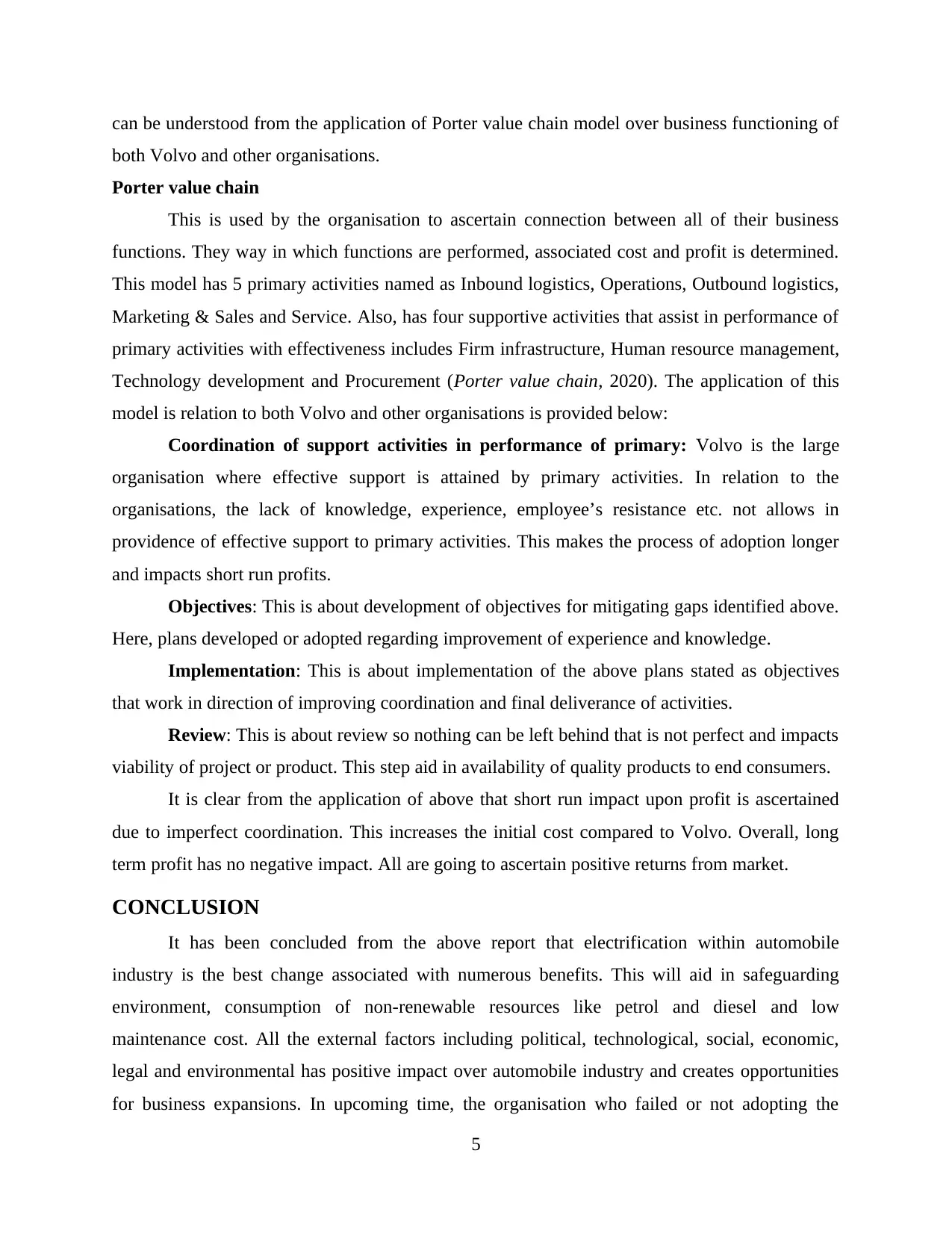
can be understood from the application of Porter value chain model over business functioning of
both Volvo and other organisations.
Porter value chain
This is used by the organisation to ascertain connection between all of their business
functions. They way in which functions are performed, associated cost and profit is determined.
This model has 5 primary activities named as Inbound logistics, Operations, Outbound logistics,
Marketing & Sales and Service. Also, has four supportive activities that assist in performance of
primary activities with effectiveness includes Firm infrastructure, Human resource management,
Technology development and Procurement (Porter value chain, 2020). The application of this
model is relation to both Volvo and other organisations is provided below:
Coordination of support activities in performance of primary: Volvo is the large
organisation where effective support is attained by primary activities. In relation to the
organisations, the lack of knowledge, experience, employee’s resistance etc. not allows in
providence of effective support to primary activities. This makes the process of adoption longer
and impacts short run profits.
Objectives: This is about development of objectives for mitigating gaps identified above.
Here, plans developed or adopted regarding improvement of experience and knowledge.
Implementation: This is about implementation of the above plans stated as objectives
that work in direction of improving coordination and final deliverance of activities.
Review: This is about review so nothing can be left behind that is not perfect and impacts
viability of project or product. This step aid in availability of quality products to end consumers.
It is clear from the application of above that short run impact upon profit is ascertained
due to imperfect coordination. This increases the initial cost compared to Volvo. Overall, long
term profit has no negative impact. All are going to ascertain positive returns from market.
CONCLUSION
It has been concluded from the above report that electrification within automobile
industry is the best change associated with numerous benefits. This will aid in safeguarding
environment, consumption of non-renewable resources like petrol and diesel and low
maintenance cost. All the external factors including political, technological, social, economic,
legal and environmental has positive impact over automobile industry and creates opportunities
for business expansions. In upcoming time, the organisation who failed or not adopting the
5
both Volvo and other organisations.
Porter value chain
This is used by the organisation to ascertain connection between all of their business
functions. They way in which functions are performed, associated cost and profit is determined.
This model has 5 primary activities named as Inbound logistics, Operations, Outbound logistics,
Marketing & Sales and Service. Also, has four supportive activities that assist in performance of
primary activities with effectiveness includes Firm infrastructure, Human resource management,
Technology development and Procurement (Porter value chain, 2020). The application of this
model is relation to both Volvo and other organisations is provided below:
Coordination of support activities in performance of primary: Volvo is the large
organisation where effective support is attained by primary activities. In relation to the
organisations, the lack of knowledge, experience, employee’s resistance etc. not allows in
providence of effective support to primary activities. This makes the process of adoption longer
and impacts short run profits.
Objectives: This is about development of objectives for mitigating gaps identified above.
Here, plans developed or adopted regarding improvement of experience and knowledge.
Implementation: This is about implementation of the above plans stated as objectives
that work in direction of improving coordination and final deliverance of activities.
Review: This is about review so nothing can be left behind that is not perfect and impacts
viability of project or product. This step aid in availability of quality products to end consumers.
It is clear from the application of above that short run impact upon profit is ascertained
due to imperfect coordination. This increases the initial cost compared to Volvo. Overall, long
term profit has no negative impact. All are going to ascertain positive returns from market.
CONCLUSION
It has been concluded from the above report that electrification within automobile
industry is the best change associated with numerous benefits. This will aid in safeguarding
environment, consumption of non-renewable resources like petrol and diesel and low
maintenance cost. All the external factors including political, technological, social, economic,
legal and environmental has positive impact over automobile industry and creates opportunities
for business expansions. In upcoming time, the organisation who failed or not adopting the
5
Paraphrase This Document
Need a fresh take? Get an instant paraphrase of this document with our AI Paraphraser

concept of electrification has to face negative consequences in form of less returns and low level
profitability.
6
profitability.
6
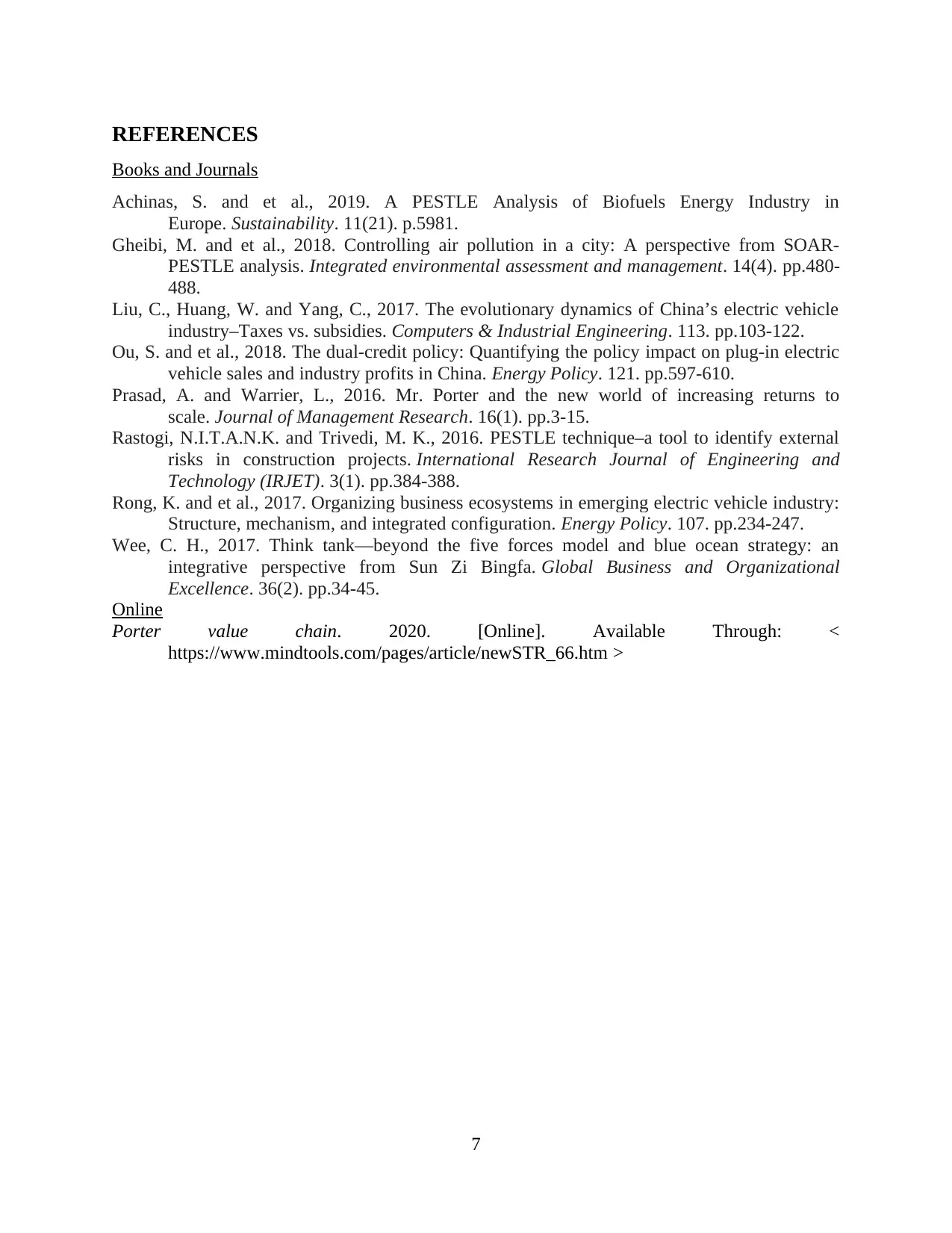
REFERENCES
Books and Journals
Achinas, S. and et al., 2019. A PESTLE Analysis of Biofuels Energy Industry in
Europe. Sustainability. 11(21). p.5981.
Gheibi, M. and et al., 2018. Controlling air pollution in a city: A perspective from SOAR‐
PESTLE analysis. Integrated environmental assessment and management. 14(4). pp.480-
488.
Liu, C., Huang, W. and Yang, C., 2017. The evolutionary dynamics of China’s electric vehicle
industry–Taxes vs. subsidies. Computers & Industrial Engineering. 113. pp.103-122.
Ou, S. and et al., 2018. The dual-credit policy: Quantifying the policy impact on plug-in electric
vehicle sales and industry profits in China. Energy Policy. 121. pp.597-610.
Prasad, A. and Warrier, L., 2016. Mr. Porter and the new world of increasing returns to
scale. Journal of Management Research. 16(1). pp.3-15.
Rastogi, N.I.T.A.N.K. and Trivedi, M. K., 2016. PESTLE technique–a tool to identify external
risks in construction projects. International Research Journal of Engineering and
Technology (IRJET). 3(1). pp.384-388.
Rong, K. and et al., 2017. Organizing business ecosystems in emerging electric vehicle industry:
Structure, mechanism, and integrated configuration. Energy Policy. 107. pp.234-247.
Wee, C. H., 2017. Think tank—beyond the five forces model and blue ocean strategy: an
integrative perspective from Sun Zi Bingfa. Global Business and Organizational
Excellence. 36(2). pp.34-45.
Online
Porter value chain. 2020. [Online]. Available Through: <
https://www.mindtools.com/pages/article/newSTR_66.htm >
7
Books and Journals
Achinas, S. and et al., 2019. A PESTLE Analysis of Biofuels Energy Industry in
Europe. Sustainability. 11(21). p.5981.
Gheibi, M. and et al., 2018. Controlling air pollution in a city: A perspective from SOAR‐
PESTLE analysis. Integrated environmental assessment and management. 14(4). pp.480-
488.
Liu, C., Huang, W. and Yang, C., 2017. The evolutionary dynamics of China’s electric vehicle
industry–Taxes vs. subsidies. Computers & Industrial Engineering. 113. pp.103-122.
Ou, S. and et al., 2018. The dual-credit policy: Quantifying the policy impact on plug-in electric
vehicle sales and industry profits in China. Energy Policy. 121. pp.597-610.
Prasad, A. and Warrier, L., 2016. Mr. Porter and the new world of increasing returns to
scale. Journal of Management Research. 16(1). pp.3-15.
Rastogi, N.I.T.A.N.K. and Trivedi, M. K., 2016. PESTLE technique–a tool to identify external
risks in construction projects. International Research Journal of Engineering and
Technology (IRJET). 3(1). pp.384-388.
Rong, K. and et al., 2017. Organizing business ecosystems in emerging electric vehicle industry:
Structure, mechanism, and integrated configuration. Energy Policy. 107. pp.234-247.
Wee, C. H., 2017. Think tank—beyond the five forces model and blue ocean strategy: an
integrative perspective from Sun Zi Bingfa. Global Business and Organizational
Excellence. 36(2). pp.34-45.
Online
Porter value chain. 2020. [Online]. Available Through: <
https://www.mindtools.com/pages/article/newSTR_66.htm >
7
⊘ This is a preview!⊘
Do you want full access?
Subscribe today to unlock all pages.

Trusted by 1+ million students worldwide
1 out of 9
Related Documents
Your All-in-One AI-Powered Toolkit for Academic Success.
+13062052269
info@desklib.com
Available 24*7 on WhatsApp / Email
![[object Object]](/_next/static/media/star-bottom.7253800d.svg)
Unlock your academic potential
Copyright © 2020–2025 A2Z Services. All Rights Reserved. Developed and managed by ZUCOL.





